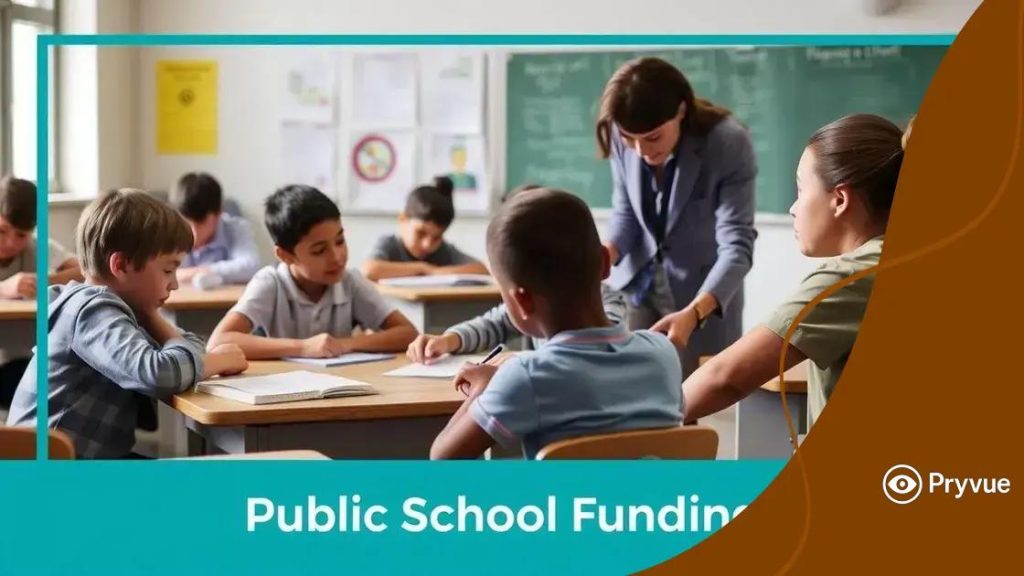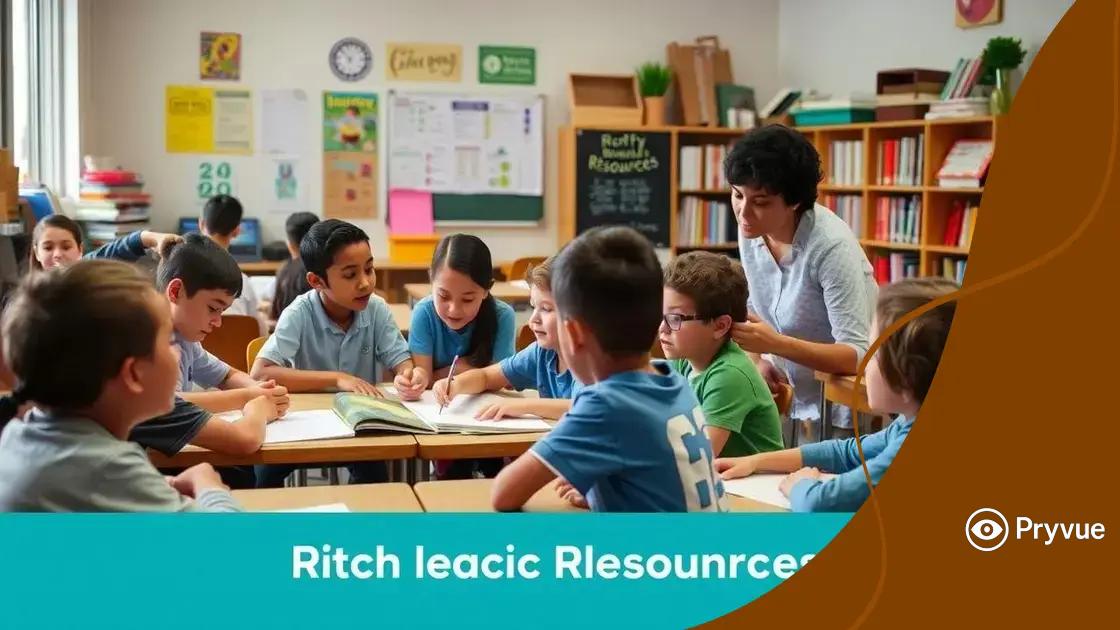Funding for public schools 2025: what to expect

Anúncios
Funding for public schools is essential to provide quality education, enhance resources for students and teachers, and ensure equitable access to educational opportunities across various school districts.
Funding for public schools 2025 is a crucial topic that affects every student and educator in our communities. With changes on the horizon, you might be wondering how these adjustments could reshape your child’s educational experience.
Anúncios
Overview of public school funding in 2025
Understanding the overview of public school funding in 2025 is essential for grasping how educational resources are allocated. Many changes are on the horizon, influenced by policy shifts and community involvement. Changes in government budgets and local initiatives will shape how schools operate.
Key Aspects of School Funding
The primary sources of funding for public schools usually come from federal, state, and local levels. Each of these plays a vital role in ensuring educational quality, but their contributions can vary significantly.
- Federal Funding: Typically includes grants and programs specifically aimed at enhancing educational opportunities.
- State Funding: Often constitutes the largest share of school budgets, determined by state legislatures.
- Local Funding: Generally derived from property taxes, which can lead to disparities between wealthier and less affluent districts.
As we look ahead, it’s important to highlight the potential impacts these funding sources will have on students. For instance, school districts that receive adequate funding can provide more comprehensive programs. This may include advanced placement courses and extracurricular activities that develop students’ talents.
Anúncios
Recent Changes in Policies
In recent years, several policies have been proposed that could enhance funding for public schools in 2025. These policies aim to address equity issues in funding, ensuring that all students have access to quality education regardless of their background.
Moreover, community members are becoming increasingly active in discussions about school funding. Programs that encourage community involvement can lead to better funding proposals and outreach. Schools that work closely with their local communities often find that they can rally financial support through events and partnerships.
Ultimately, an informed public is critical for advocating for adequate school funding. By addressing the sources of funding and engaging with policies, people can help shape the future of education in their areas. Keeping abreast of these developments is essential for anyone invested in the education sector.
Key changes in funding sources
In recent years, understanding the key changes in funding sources for public schools has become vital. These changes can greatly impact how schools operate and the resources they provide for students.
Shifts in Government Funding
One major change is the way government funding is allocated. State governments are increasingly considering factors like student enrollment and socioeconomic status when distributing funds. This approach aims to reduce gaps between districts.
- Weighted Funding: More attention is given to students with special needs, English language learners, and low-income backgrounds.
- Performance-Based Funding: Some states are starting to link funding to schools’ performance metrics, encouraging improvements in education quality.
- Transparency Initiatives: Increased focus on making funding distribution more transparent helps communities understand how resources are allocated.
In addition to government funding, private donations and grants play a growing role. Many schools are exploring partnerships with local businesses and non-profits to secure additional resources. These partnerships not only provide funds but also offer mentorship and internship opportunities for students.
Impact of Federal Programs
Federal programs like Title I have also evolved. These programs are designed to support schools with high concentrations of low-income students. As regulations change, schools have to adapt to new requirements and potentially new sources of funding.
Furthermore, the federal government has increased attention on investing in technology and infrastructure to enhance learning experiences. This means that funds are being directed towards upgrading classrooms and providing digital tools to students.
Ultimately, adapting to these key changes in funding sources is crucial for ensuring that public schools can meet the needs of all students. By understanding where funding comes from and how it’s changing, communities can advocate for resources that support effective education.
Impact of funding on students and teachers

The impact of funding on students and teachers is significant. Adequate funding can enhance the educational experience for both students and educators, making it a critical factor in public education.
Resources Available to Students
When schools receive proper funding, they can provide a variety of resources that benefit students. This includes access to updated textbooks, advanced technology, and extracurricular activities that enrich the learning environment.
- Technology Integration: With sufficient funding, schools can equip classrooms with computers and software that facilitate learning.
- Special Programs: Funding enables schools to run programs in arts, sports, and STEM, which are crucial for a well-rounded education.
- Smaller Class Sizes: More funds can allow for hiring additional teachers, leading to smaller class sizes. This helps in giving students more individual attention.
As students benefit from these resources, their overall performance and engagement levels are likely to improve. Schools with quality materials and support often see higher attendance rates and better test scores.
The Role of Teachers
Funding also plays a vital role in supporting teachers. With adequate financial resources, schools can provide ongoing professional development and training opportunities. This ensures that educators are equipped with the latest teaching strategies and understand best practices.
Moreover, competitive salaries are essential to attract and retain talented teachers. When educators feel valued and well-compensated, they are more likely to be motivated and committed to their students’ success. In turn, this creates a positive learning atmosphere, which is vital for student achievement.
Furthermore, having access to necessary teaching materials can make a big difference. When teachers are supported with the right resources—from classroom supplies to technology—they can focus on what truly matters: helping students learn and grow.
Ultimately, the impact of funding can be seen in improved student outcomes and teacher satisfaction. Investing in education is not just beneficial; it’s essential for building a brighter future for everyone involved.
Community involvement in school funding
Community involvement in school funding has become an important factor in ensuring that schools receive adequate resources. Engaging local community members can lead to significant benefits in educational funding and support.
Ways Communities Can Contribute
Communities can actively participate in school funding in several effective ways. When parents, local businesses, and community organizations come together, they can create a supportive environment for schools.
- Fundraising Events: Organizing events like bake sales, car washes, or fun runs can raise money for specific school programs.
- Partnerships with Local Businesses: Forming partnerships with businesses can lead to sponsorships that provide financial support and resources.
- Grants and Donations: Local foundations and organizations may offer grants to help schools with specific needs or projects.
Moreover, community involvement fosters a sense of ownership and pride in local schools. When parents and residents are engaged, they often become advocates for more funding and better resources. This grassroots support can influence local policy and encourage school boards to prioritize educational funding.
The Benefits of Engaged Communities
Engaged communities often see improved relationships between schools and families. Communication improves, and families feel more connected to their children’s education. This connection is crucial, as it leads to higher student success rates and satisfaction.
Furthermore, when communities rally around schools, they can call attention to funding needs that may not have been addressed by government sources. This increased visibility can help attract additional funding from various sources, including state and federal programs.
In summary, community involvement in school funding benefits everyone involved. It leads to more resources for students and empowers families to take part in the educational process, ultimately enhancing the quality of education provided in local schools.
Future outlook for public education funding
The future outlook for public education funding is a topic of vital importance. Changes in policies, community involvement, and economic factors will play significant roles in shaping how schools are funded in the years to come.
Emerging Trends in Funding
One trend we are seeing is a shift towards more equitable funding practices. Policymakers are recognizing the disparities in funding that exist between affluent and low-income districts. As a result, there are movements aimed at redirecting funds to ensure that every student receives a fair opportunity to succeed.
- Focus on Equity: Many states are reevaluating their funding formulas to address inequalities based on student needs.
- Increased Local Engagement: Communities are becoming more involved in advocating for school funding, leading to greater local support.
- Sustainability Initiatives: Schools are starting to prioritize funding for programs that promote environmental awareness and sustainability.
Moreover, federal and state governments are beginning to invest more in technology and online learning resources. This is especially important as educational methods continue to evolve. With the rise of digital learning, schools that receive funding can enhance their technological infrastructure, making education more accessible.
Potential Challenges
Despite positive trends, there will be challenges ahead. Economic downturns can impact funding levels, leading to budget cuts that affect programs. Policymakers will need to navigate these hurdles carefully to protect school resources.
Additionally, the debate over how funding should be allocated is likely to continue. Different stakeholders will have varying opinions on priorities, which may complicate funding decisions. Striking a balance between addressing immediate needs and long-term goals will be crucial.
In the end, the future outlook for public education funding remains uncertain but filled with potential. With active community engagement and a focus on equity, the landscape can improve significantly. However, careful management and advocacy will be essential to ensure that all students receive the quality education they deserve.
FAQ – Frequently Asked Questions about Funding for Public Schools
What is the importance of funding for public schools?
Funding is crucial as it directly impacts the quality of education, resources available, and overall student success.
How can communities get involved in school funding?
Communities can participate through fundraising events, partnerships with local businesses, and advocating for better funding policies.
What are some key trends in public school funding for the future?
Key trends include a focus on equitable funding, increased local engagement, and prioritizing technology and resources for online learning.
What challenges might affect future school funding?
Potential challenges include economic downturns, budget cuts, and ongoing debates over funding allocation priorities.